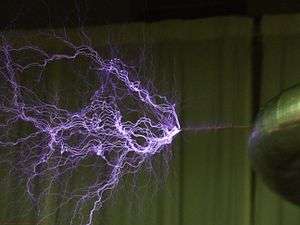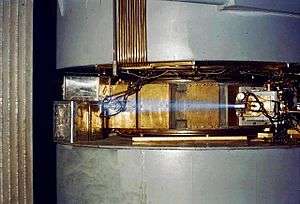Ionized-air glow
Ionized-air glow is the fluorescent emission of characteristic blue–purple–violet light, often of a color called electric blue, by air subjected to an energy flux.




Processes
When energy is deposited to air, the air molecules become excited. As air is composed primarily of nitrogen and oxygen, excited N2 and O2 molecules are produced. These can react with other molecules, forming mainly ozone and nitrogen(II) oxide. Water vapor, when present, may also play a role; its presence is characterized by the hydrogen emission lines. The reactive species present in the plasma can readily react with other chemicals present in the air or on nearby surfaces.
Deexcitation of nitrogen
The excited nitrogen deexcites primarily by emission of a photon, with emission lines in ultraviolet, visible, and infrared band:
- N2* → N2 + hν
The blue light observed is produced primarily by this process.[1] The spectrum is dominated by lines of single-ionized nitrogen, with presence of neutral nitrogen lines.
Deexcitation of oxygen
The excited state of oxygen is somewhat more stable than nitrogen. While deexcitation can occur by emission of photons, more probable mechanism at atmospheric pressure is a chemical reaction with other oxygen molecules, forming ozone:[1]
- O2* + 2 O2 → 2 O3
This reaction is responsible for the production of ozone in the vicinity of strongly radioactive materials and electrical discharges.
Occurrence
Excitation energy can be deposited in air by a number of different mechanisms:
- Ionizing radiation is the cause of blue glow surrounding sufficient quantities of strongly radioactive materials in air, e.g. some radioisotope specimens (e.g. radium or polonium), particle beams (e.g. from particle accelerators) in air, the blue flashes during criticality accidents, and the eerie/low brightness "purple" to "blue" glow enveloping the mushroom cloud during the first several dozen seconds after nuclear explosions near sea level. This post-explosion effect has been observed only at night from atmospheric nuclear tests owing to its low brightness, with observers noticing it following the pre-dawn Trinity (test),[2][3][4][5] Upshot-Knothole Annie,[6] and the Cherokee shot of Operation Redwing.[7][8]The emission of blue light is often incorrectly attributed to Cherenkov radiation.[7] For more on ionized air glow by nuclear explosions see the near local midnight, high altitude test shot, Bluegill Triple Prime.
 This night shot of Upshot-Knothole Annie nuclear bomb test was televised and gives a rare record of both the un-edited sound and appearance (in black and white) of a nuclear explosion. After this picture was taken, a blue ionized air glow persisted around the mushroom cloud.[9]
This night shot of Upshot-Knothole Annie nuclear bomb test was televised and gives a rare record of both the un-edited sound and appearance (in black and white) of a nuclear explosion. After this picture was taken, a blue ionized air glow persisted around the mushroom cloud.[9] - Within minutes after the steam explosion that caused the Chernobyl accident at 01:23 local time, a number of employees at the power station went outside to get a clearer view of the extent of the damage. One such survivor, Alexander Yuvchenko, recounts that once he stopped outside and looked up towards the reactor hall he saw a "very beautiful" laser-like beam of light bluish light, caused by the ionization of air, that appeared to flood up into infinity.[10][11][12]
- Cathode rays in air produce this blue glow.[13]
- Electrical discharge in air is the cause of blue light emitted by electric sparks, lightning, and corona discharges (e.g. St. Elmo's fire).
- Auroras, the sometimes observable blue-violet hues emitted by nitrogen at lower altitudes
Colors
In dry air, the color of produced light (e.g. by lightning) is dominated by the emission lines of nitrogen, yielding the spectrum with primarily blue emission lines. The lines of neutral nitrogen (NI), neutral oxygen (OI), singly ionized nitrogen (NII) and singly ionized oxygen (OII) are the most prominent features of a lightning emission spectrum.[14]
Neutral nitrogen radiates primarily at one line in red part of the spectrum. Ionized nitrogen radiates primarily as a set of lines in blue part of the spectrum.[15] The strongest signals are the 443.3, 444.7, and 463.0 nm lines of singly ionized nitrogen.[16]
Violet hue can occur when the spectrum contains emission lines of atomic hydrogen. This may happen when the air contains high amount of water, e.g. with lightnings in low altitudes passing through rain thunderstorms. Water vapor and small water droplets ionize and dissociate easier than large droplets, therefore have higher impact on color.[17]
The hydrogen emission lines at 656.3 nm (the strong H-alpha line) and at 486.1 nm (H-beta) are characteristic for lightnings.[18]
Rydberg atoms, generated by low-frequency lightnings, emit at red to orange color and can give the lightning a yellowish to greenish tint.[17]
Generally, the radiant species present in atmospheric plasma are N2, N2+, O2, NO (in dry air) and OH (in humid air). The temperature, electron density, and electron temperature of the plasma can be inferred from the distribution of rotational lines of these species. At higher temperatures, atomic emission lines of N and O, and (in presence of water) H, are present. Other molecular lines, e.g. CO and CN, mark presence of contaminants in the air.[19]
Ionized air glow vs Cherenkov radiation
Despite the similarity of light color produced, the Cherenkov radiation is generated by a fundamentally different mechanism.
Cherenkov radiation is produced by charged particles which are traveling through a dielectric substance at a speed greater than the speed of light in that medium. The only types of charged particle radiation produced in the process of a criticality accident (fission reactions) are alpha particles, beta particles, positrons (which all come from the radioactive decay of unstable daughter products of the fission reaction) and energetic ions which are the daughter products themselves. Of these, only beta particles have sufficient penetrating power to travel more than a few centimeters in air. Since air is a very low density material, its index of refraction (around n=1.0002926) differs very little from that of a vacuum (n=1) and consequently the speed of light in air is only about 0.03% slower than its speed in a vacuum. Therefore, a beta particle emitted from decaying fission products would need to have a velocity greater than 99.97% c in order to produce Cherenkov radiation. Because the energy of beta particles produced during nuclear decay do not exceed energies of about 20 MeV (20.6 MeV for 14B is likely the most energetic with 17.9 MeV for 23Na being the next highest energy beta emitter[20]) and the energy needed for a beta particle to attain 99.97% c is 21.1 MeV , the possibility of Cherenkov radiation produced in air via a fission criticality or a radioactive decay is virtually eliminated.
Cherenkov radiation can be however readily observed in more optically dense environments, e.g. in water or in transparent solids.
See also
- Airglow
- List of plasma (physics) articles
References
- Inorganic chemistry by Egon Wiberg, Nils Wiberg, Arnold Frederick Holleman, p. 1655, Academic Press, 2001, ISBN 0-12-352651-5
- "The Trinity Test: 'An eery and awesome sight' by Robert Christy". Archived from the original on 2014-03-07. Retrieved 2014-11-08.
- National Academy of Sciences, Robert F. Christy by Goldstein pg 7
- "Eyewitnesses to Trinity" (PDF). Nuclear Weapons Journal, Issue 2 2005. Los Alamos National Laboratory. 2005. p. 45. Retrieved 18 February 2014.
- ROBERT F. CHRISTY (1916- 2012) INTERVIEWED BY SARA LIPPINCOTT
- Cherokee Field Report Bikini Operations, page 10, quoted in Chuck Hansen, The swords of Armageddon: U.S. nuclear weapons development since 1945 (Sunnyvale, CA : Chukelea Publications, 1995), 1307
- Camera-man Yoshitake -"For several minutes after the blast, you could see this eerie ultraviolet glow high up in the sky. And I thought that was so spectacular, so meaningful."
- Operation Upshot-Knothole Shot Annie, Youtube.com, retrieved October 27, 2013
- "Cheating Chernobyl This interview was first published in New Scientist print edition Source : New Scientist web site".
- "Chernobyl 20 years on".
- "Chernobyl: what happened and why? by CM Meyer, technical journalist" (PDF). Archived from the original (PDF) on 2013-12-11.
- The Becquerel Rays and the Properties of Radium by R. J. Strutt, p. 20, Courier Dover Publications, 2004 ISBN 0-486-43875-9
- Lightning by Martin A. Uman, p. 139, Courier Dover Publications, 1984 ISBN 0-486-64575-4
- All about lightning by Martin A. Uman, p. 96, Courier Dover Publications, 1986 ISBN 0-486-25237-X
- PhysForum Science, Physics and Technology Discussion Forums -> Colours of electiricy. Physforum.com. Retrieved on 2010-06-05.
- AMS Journals Online – Daylight Spectra of Individual Lightning Flashes in the 370–690 nm Region. Journals.ametsoc.org. Retrieved on 2010-06-05.
- Laux, C O; Spence, T G; Kruger, C H; Zare, R N (2003). "Optical diagnostics of atmospheric pressure air plasmas" (PDF). Plasma Sources Science and Technology. 12 (2): 125. Bibcode:2003PSST...12..125L. doi:10.1088/0963-0252/12/2/301. Archived from the original (PDF) on 2011-07-16. Retrieved 2010-05-27.
- Decay Radiation Search